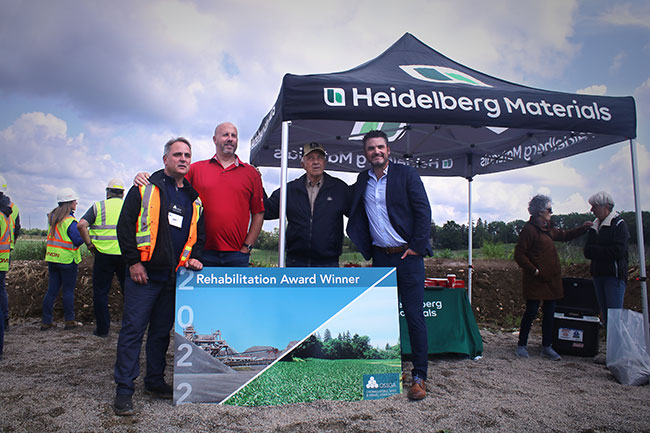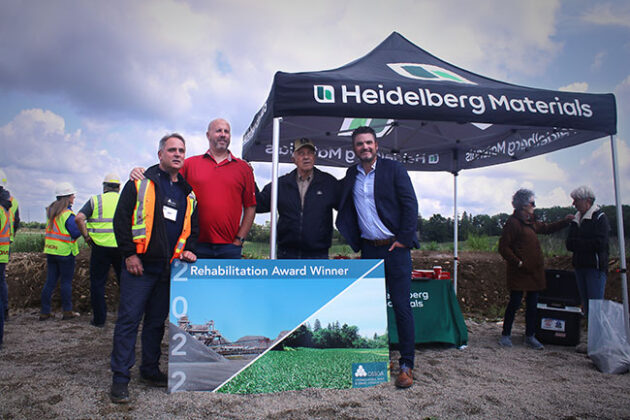
Features
Pits & Quarries
Early to rise
Early rehabilitation can make pits healthier, wealthier and wiser
September 18, 2023 By Elizabeth Bate
 Left to right:
Ken Zimmerman, Tim Edworthy, John Edworthy and Kevin Hurley in North Dumfries, Ont.
Left to right:
Ken Zimmerman, Tim Edworthy, John Edworthy and Kevin Hurley in North Dumfries, Ont. It’s a cool spring day in the middle of June as John Edworthy and his son Tim show off a 40-acre section of their farmland.
The corn is just starting to take shape on this part of the land. The wide, green fields paint a pastoral picture and looking at it, you’d never know that just a few short years ago this section was part of the active North Dumfries quarry pit.
North Dumfries Pit award-winning example
The Edworthys are partners with Heidelberg Materials and Cambridge Aggregates, leasing the companies the land for the pit in North Dumfries, Ont., and taking an active role in its rehabilitation.
The team was presented with the 2022 Judges’ Choice Award in progressive rehabilitation from the Ontario Stone, Sand and Gravel Association (OSSGA) at an on-site presentation June 14. The presentation was part of a larger tour of rehabilitation projects in Southwestern Ontario.
Heidelberg general manager Kevin Hurley says the group has worked closely together to make sure the site meets its goal of continuing to be productive agricultural land even before the pit’s licence is surrendered.
“We’ve progressively rehabbed this site. It serviced the local Waterloo region community with aggregates for their buildings that are going up, and houses and roads. To get it back to beautiful farmland and have the farmers be happy with how the crops are going as soon as possible — it’s nice to have a good news story,” Hurley said.
Each year the area being farmed at the North Dumfries Pit grows a little larger, starting as beans before moving to corn — all cash crops. The progressive work allows the soil to settle and become part of the land once again.
The next phase of the plan for the pit involves adding even more active farmland, as well as restoring the native ecological system by adding Oak Savannah, Woodland and prairie and native grassland.
Early rehabilitation is key
Farming isn’t the usual business of pit operators, but OSSGA board member Ken Zimmerman thinks it should be incorporated into operations more.
“The industry’s changed over the last 20 to 30 years. There’s really no reason to wait until the end to progressively rehabilitate a site,” he said.
Incorporating early rehabilitation into site plans, even before a pit’s license is surrendered, can have benefits for quarry operators, farmers, and the surrounding communities, says Zimmerman.
“There’s all kinds of benefits to getting it done sooner, rather than later. Why would you wait until the end? You have to move soil, it costs more money to move the soil twice, and you don’t want the soil sitting, so why would you not want it back on the floor… for agricultural use?”
Zimmerman said allowing soil to sit in storage for too long may even be harmful to future use, killing the nutrients. Reintegrating the soil with the land sooner allows it to settle, creating a better environment for future crops.

Left to right:
Ken Zimmerman, Tim Edworthy, John Edworthy and Kevin Hurley in North Dumfries, Ont.
Advanced rehab is a worthy endeavour
When creating a plan for rehabilitation of a site, going above and beyond minimum requirements and engaging in advanced projects may generate income in unique ways.
The rehabilitation of the McMillian Pit in Puslinch, Ont., a combined effort from CBM Aggregates and Izumi Aquiculture, began in 2014 as a way to restore natural balance and create a profitable agriculture business.
Where once CBM mined below the water table here, now the pit is a man-made pond, home to fresh farm-to-table fish being sold in the community and surrounding areas. Izumi says it has even taken orders from local restaurants that plate the product for dinner the same day.
The advanced rehabilitation project created not just the pond with a floating “raceway” style of fish breeding area, but planting trees and creating wetlands to renew the local flora and fauna.
Everything at the McMillian Pit goes back into helping renew the area, including fish waste products, which are used as super-fertilizer on this and other sites.
Early Rehab makes good neighbours
Tim Edworthy’s daily view of the North Dumfries Pit is as close as they come; the landowner’s home still sits right next door to the operation.
Edworthy says the lack of a crusher on the site, as well as strict regulations about operating hours, mean the pit has been quiet and respectful during their tenure.
“They’re the best neighbours you could ask for,” he said.
This flies in the face of recent negative press coverage insisting pits and quarries are loud, destructive and cannot be returned to their natural state; an opinion Hurley says is simply wrong.
“Often you only hear one side of the story and it’s not necessarily fact based. Getting that information out there hopefully helps people to understand the reality,” he said. “This is sustainable construction at its finest.”
OSSGA director of environment and sustainability Ashlee Zelek says the Judges’ Choice Award is meant to draw attention to the importance of progressive rehabilitation.
“The Judges’ Choice award celebrates the techniques and approaches to progressive rehabilitation,” she says. “It’s important for the community to see and understand that extracted areas of the site are being continually restored.”
Print this page